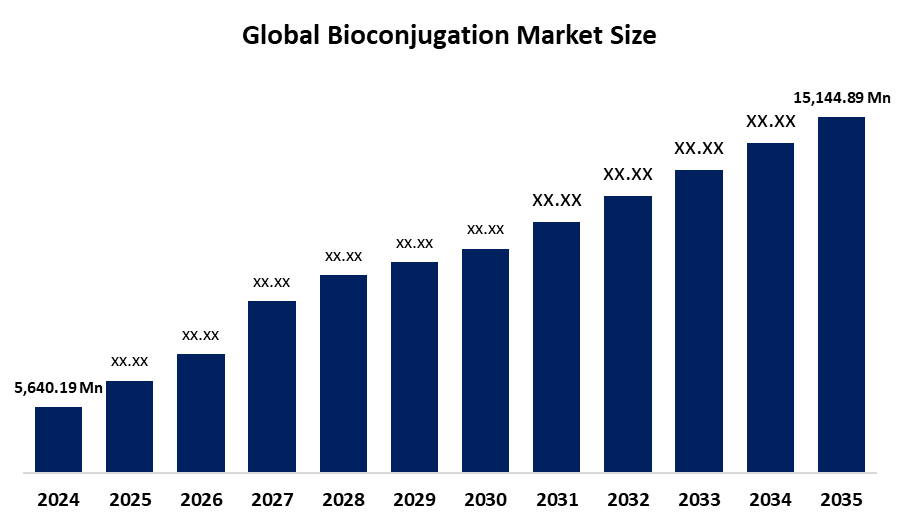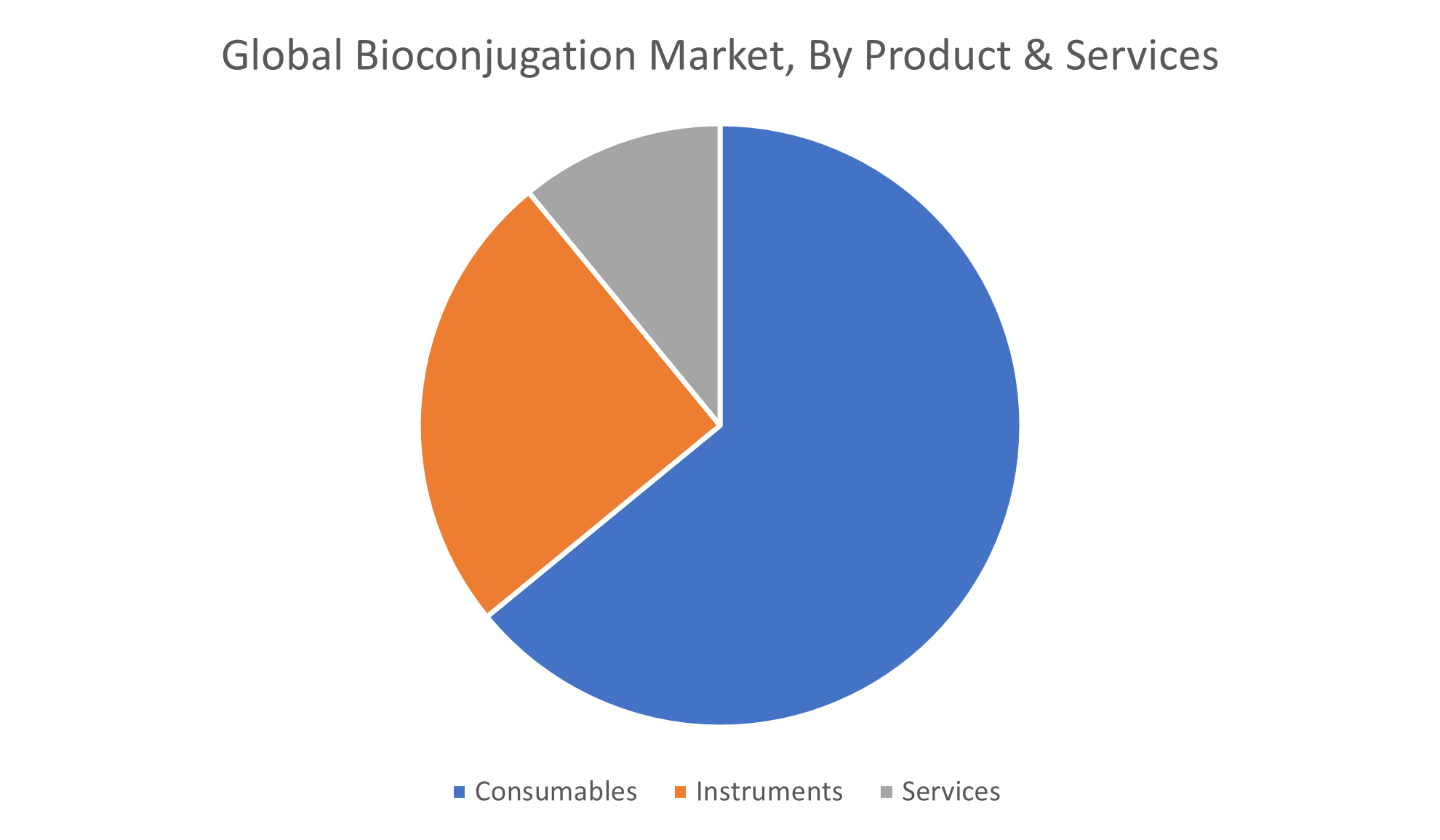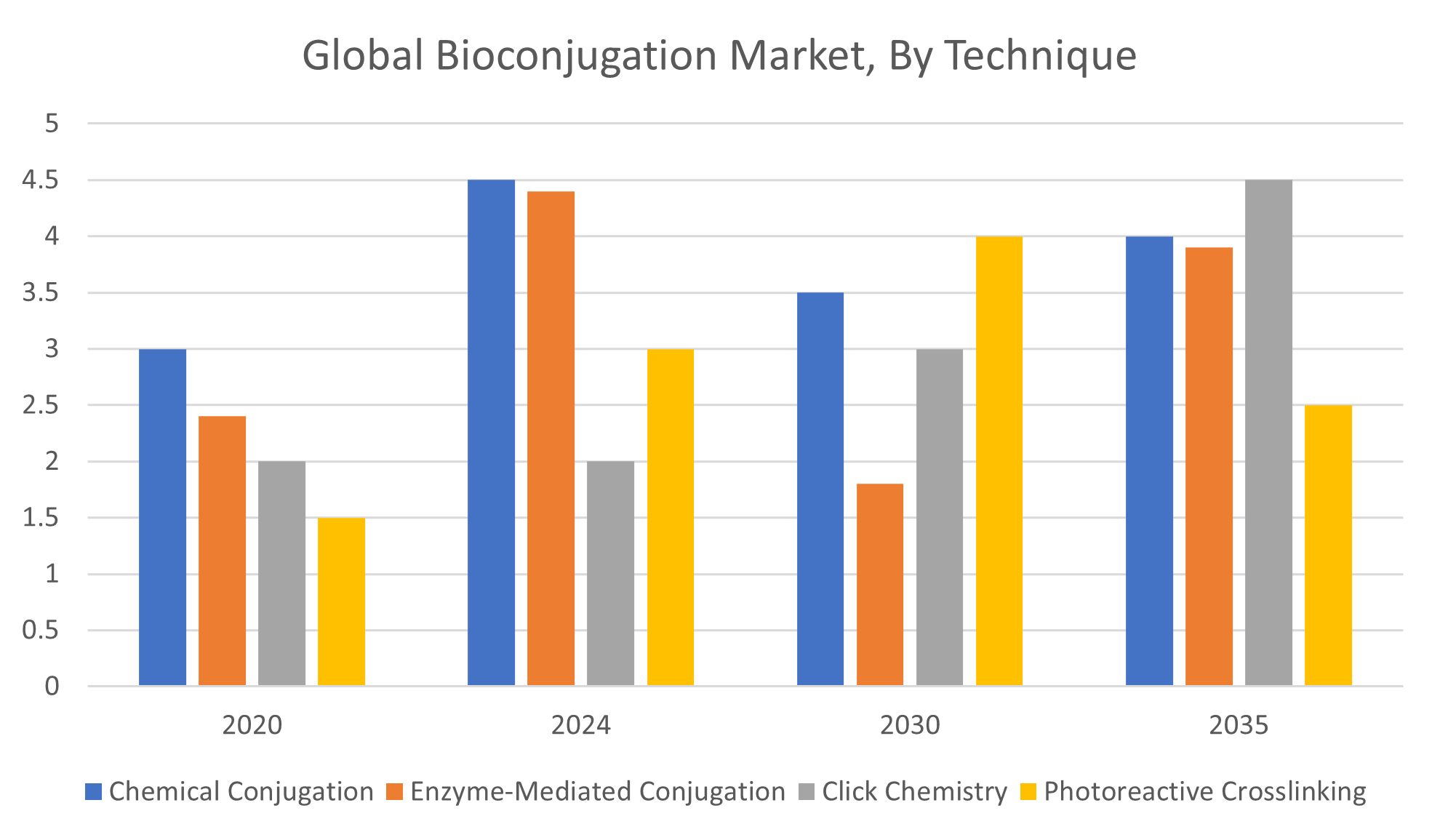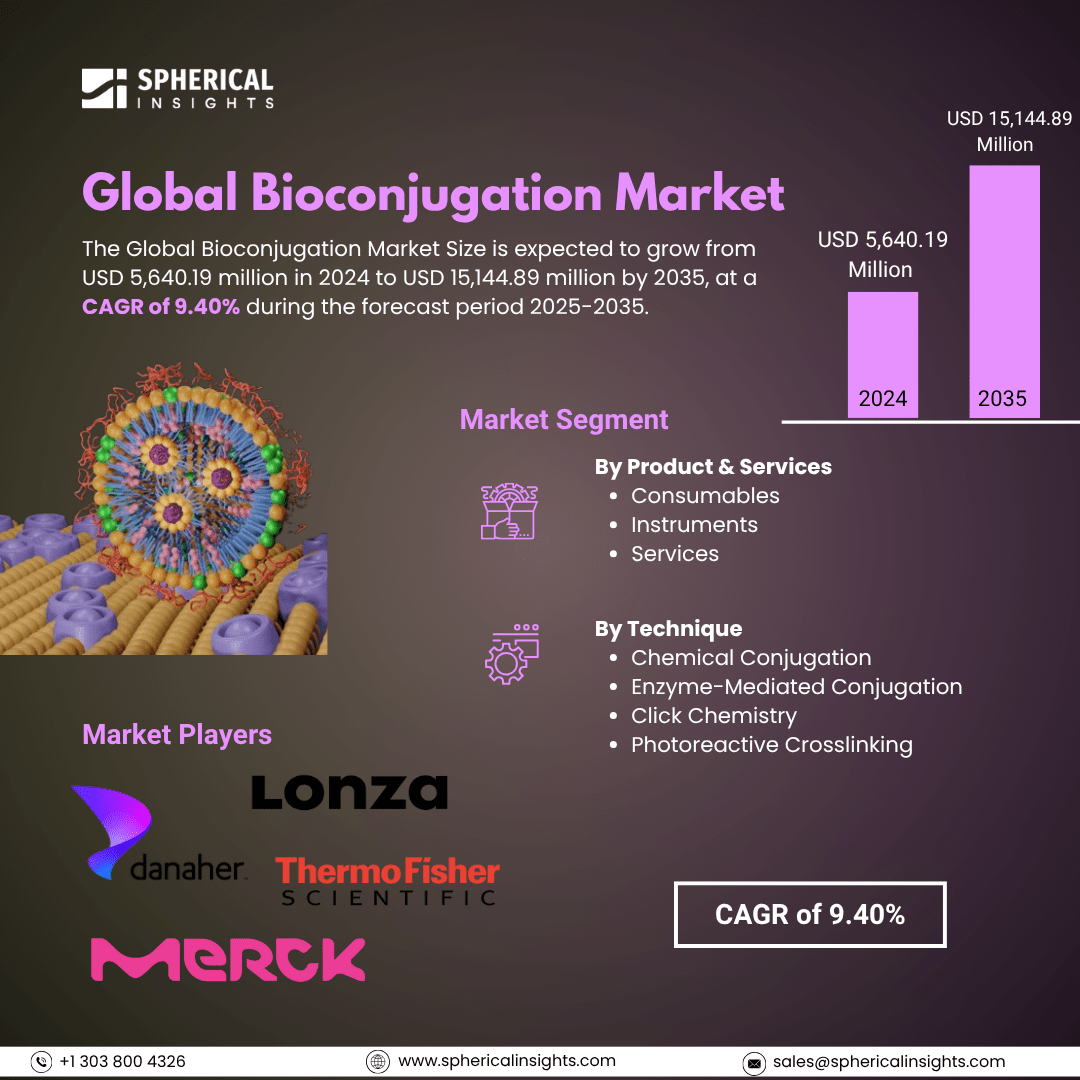Global Bioconjugation Market Insights Forecasts to 2035
- The Global Bioconjugation Market Size Was Estimated at USD 5,640.19 Million in 2024
- The Market Size is Expected to Grow at a CAGR of around 9.40% from 2025 to 2035
- The Worldwide Bioconjugation Market Size is Expected to Reach USD 15,144.89 Million by 2035
- Asia Pacific is Expected to grow the fastest during the forecast period.

Bioconjugation Market
The global bioconjugation market involves the process of chemically linking two molecules to create a single functional product, often combining a biomolecule, such as an antibody or enzyme, with another molecule like a drug or imaging agent. This process is widely used in biotechnology, pharmaceutical research, diagnostics, and therapeutic applications, especially in the development of targeted drug delivery systems and advanced diagnostic tools. Bioconjugation techniques enable precise targeting and improved functionality of therapeutic agents, making them valuable in areas such as oncology, immunology, and infectious disease treatment. The market includes various products such as reagents, kits, and linkers used in conjugation procedures. Key applications of bioconjugates include antibody-drug conjugates (ADCs), fluorescent labeling, and enzyme-linked immunosorbent assays (ELISA). The market landscape consists of both established players and emerging companies focusing on innovation and product development. With expanding research in life sciences, the bioconjugation market continues to evolve and gain significance globally.
Attractive Opportunities in the Bioconjugation Market
- Development of Next-Generation Antibody-Drug Conjugates (ADCs) with improved efficacy and fewer side effects for targeted cancer therapies.
- Expanding Genomics and Proteomics Research enabling more accurate diagnostics and personalized medicine.
- High Growth Potential in Emerging Markets like Asia-Pacific and Latin America due to increasing healthcare investments.
- Innovations in Conjugation Techniques such as site-specific and bioorthogonal chemistries enhancing product stability and expanding applications.
Global Bioconjugation Market Dynamics
DRIVER: Shift toward precision medicine is reshaping the global bioconjugation market
Evolving healthcare needs and the shift toward precision medicine are reshaping the global bioconjugation market, placing it at the forefront of modern therapeutic and diagnostic advancements. A major growth driver is the increasing adoption of antibody-drug conjugates (ADCs), which combine the targeting ability of antibodies with the potency of cytotoxic drugs for more effective treatment of diseases like cancer. The rising global burden of chronic illnesses has created a strong demand for targeted, minimally invasive therapies, further boosting the relevance of bioconjugation technologies. Continuous innovations in conjugation techniques, including site-specific methods and click chemistry, are enhancing the accuracy and functional performance of bioconjugated products. The market is also benefiting from a surge in biologics development, increased R&D investments, and strategic partnerships between biotech firms and pharmaceutical companies. Additionally, the expansion of proteomics and genomics research and government support for biomedical innovations continue to accelerate the advancement and adoption of bioconjugation across various healthcare applications.
RESTRAINT: High cost of materials, equipment, and procedures, which makes it harder for smaller companies
Although the bioconjugation market is growing, it faces several challenges that can slow its progress. One of the main issues is the high cost of materials, equipment, and procedures, which makes it harder for smaller companies and research labs to participate. The techniques used in bioconjugation are often complex and require trained professionals, which limits their use in places with fewer resources. Regulatory approval for bioconjugated drugs, such as antibody-drug conjugates, can also take a long time and involve strict safety checks. In addition, problems like maintaining consistency, product stability, and scaling up production can make it difficult to bring these products to market. The lack of standard procedures and concerns about intellectual property rights can further hold back innovation. These challenges together act as key barriers to the wider adoption and development of bioconjugation technologies across the healthcare and biotechnology industries.
OPPORTUNITY: Development of next-generation antibody-drug conjugates
One key area of potential lies in the development of next-generation antibody-drug conjugates (ADCs) for targeted cancer therapies, which offer improved efficacy with reduced side effects. Expanding research in genomics and proteomics is also creating new avenues for bioconjugation in diagnostics, enabling more accurate detection and monitoring of diseases. The rise of precision medicine and companion diagnostics further boosts demand for bioconjugated tools and assays. Emerging markets, particularly in Asia-Pacific and Latin America, offer untapped potential due to increasing healthcare investments and growing biopharmaceutical industries. Additionally, innovations in site-specific conjugation and bioorthogonal chemistry are enhancing product stability and expanding application areas. Collaborations between academic institutions, biotech startups, and large pharmaceutical companies are expected to drive innovation and commercialization. These trends collectively present promising opportunities for growth in the bioconjugation market.
CHALLENGES: Achieving precise and site-specific conjugation without compromising biomolecule function remains difficult
The bioconjugation market faces unique challenges that can hinder its growth. Achieving precise and site-specific conjugation without compromising biomolecule function remains difficult, often leading to inconsistent products. Many techniques are not easily scalable, making commercial production complex. High costs of reagents and advanced tools limit accessibility for smaller players. Additionally, the lack of standardized protocols across applications creates inefficiencies. Regulatory frameworks are still evolving, especially for newer applications like multifunctional conjugates, adding uncertainty to approval timelines. Intellectual property complexities and patent overlaps further restrict innovation, making it harder for new entrants to navigate and compete in the market effectively.
Global Bioconjugation Market Ecosystem Analysis
The global bioconjugation market ecosystem comprises biotechnology and pharmaceutical companies, research institutions, raw material suppliers, CROs, CMOs, and technology providers. These entities collaborate to develop, manufacture, and commercialize bioconjugated drugs, diagnostics, and research tools. Regulatory bodies guide product approval, while end-users like hospitals, diagnostic labs, and academic centers drive demand. This interconnected network supports innovation, scalability, and adoption across therapeutic and diagnostic applications, ensuring the market's continued advancement.
Based on the product & services, the consumables segment held the largest revenue share and is expected to grow at a significant CAGR during the forecast period

The consumables segment emerged as the largest revenue contributor in the global bioconjugation market, based on product and services, and is anticipated to witness robust growth at a significant CAGR during the forecast period. This strong market position is driven by the continuous and high-volume usage of reagents, linkers, dyes, and other essential materials in various bioconjugation applications. With increasing research activities, growing biologics development, and the expanding use of bioconjugation in diagnostics and therapeutics, the demand for reliable, high-performance consumables remains consistently high, reinforcing the segment's dominance across both academic and commercial settings.
Based on the technique, the chemical conjugation segment accounted for the highest revenue share and is expected to grow at a substantial CAGR during the forecast period

The chemical conjugation segment held the highest revenue share in the global bioconjugation market based on technique and is projected to grow at a substantial CAGR during the forecast period. This dominance is largely due to the versatility, efficiency, and widespread use of chemical conjugation methods in linking biomolecules such as proteins, antibodies, and nucleic acids with therapeutic agents, probes, or labels. Chemical conjugation techniques, including amide bond formation, click chemistry, and thiol-maleimide reactions, offer precise control and compatibility with various applications. Their continued use in drug development, diagnostics, and research ensures sustained growth of this segment globally.
North America is anticipated to hold the largest share of the bioconjugation market during the forecast period
North America is projected to lead the global bioconjugation market throughout the forecast period, driven by its advanced life sciences infrastructure and strong presence of major pharmaceutical and biotechnology companies. The region benefits from substantial investments in research and development, along with early adoption of innovative bioconjugation techniques across therapeutic and diagnostic applications. A supportive regulatory environment, combined with access to cutting-edge technologies and a skilled workforce, further enhances its market dominance. Moreover, the growing focus on personalized medicine and the high demand for targeted therapies in the U.S. and Canada continue to fuel the region’s leadership in the bioconjugation space.
Asia Pacific is expected to grow at the fastest CAGR in the bioconjugation market during the forecast period
Asia Pacific is expected to witness the fastest growth in the bioconjugation market during the forecast period, driven by increasing investments in healthcare infrastructure, rising biotechnology research, and expanding pharmaceutical manufacturing capabilities. Countries such as China, India, Japan, and South Korea are emerging as key hubs for biopharmaceutical development, supported by favorable government initiatives and funding. The growing demand for targeted therapies, personalized medicine, and advanced diagnostic tools is further propelling the adoption of bioconjugation technologies in the region. Additionally, a large patient population and the presence of cost-effective manufacturing options make Asia Pacific an attractive market for global industry players.
Recent Developments of the Bioconjugation Market
- In November 2024, Lonza announced an expansion of its bioconjugation capabilities in Visp, Switzerland, adding two 1,200L manufacturing suites and supporting infrastructure. The investment aimed to enhance commercial supply capacity and create approximately 200 new jobs, with operations expected to begin in 2028.
Key Market Players
KEY PLAYERS IN THE BIOCONJUGATION MARKET INCLUDE
- Danaher Corporation
- Lonza Group
- Thermo Fisher Scientific Inc.
- Merck KGaA
- AbbVie Inc.
- WuXi Biologics
- Sartorius AG
- Bio-Rad Laboratories, Inc.
- Genscript Biotech Corporation
- Creative Biolabs
- Abcam plc
- Others
Market Segment
This study forecasts revenue at global, regional, and country levels from 2020 to 2035. Spherical Insights has segmented the bioconjugation market based on the below-mentioned segments:
Global Bioconjugation Market, By Product & Services
- Consumables
- Instruments
- Services
Global Bioconjugation Market, By Technique
- Chemical Conjugation
- Enzyme-Mediated Conjugation
- Click Chemistry
- Photoreactive Crosslinking
Global Bioconjugation Market, By Regional Analysis
- North America
- Europe
- Germany
- UK
- France
- Italy
- Spain
- Russia
- Rest of Europe
- Asia Pacific
- China
- Japan
- India
- South Korea
- Australia
- Rest of Asia Pacific
- South America
- Brazil
- Argentina
- Rest of South America
- Middle East & Africa
- UAE
- Saudi Arabia
- Qatar
- South Africa
- Rest of the Middle East & Africa






